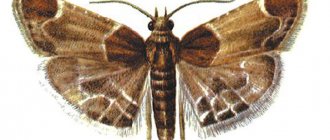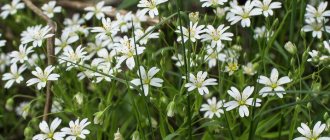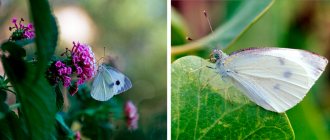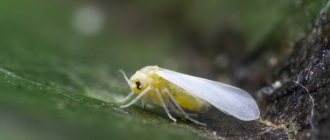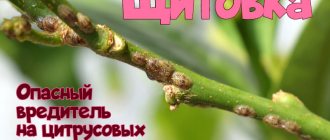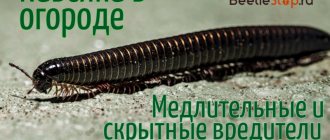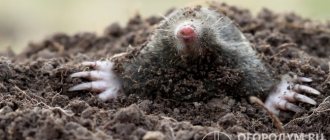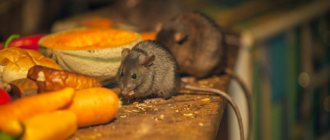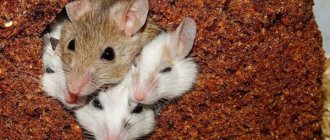Who are pests and why are they dangerous?
Parasitic insects change the plant organism. Pests attack vegetative organs, being active at different stages of bush development. The destructive effect is the result of their feeding, movement in the soil, laying of larvae and eggs.
Parasites are dangerous for all parts of raspberries:
- Kidneys – external, internal nibbling, drying out. The buds turn black, turn brown, die, and are often contaminated with cobwebs and excrement. A sign of the vital activity of raspberry weevils, butterfly caterpillars, aphids, and mites.
- Leaves - holey, rough, figured eating, skeletonizing, twisting, folding. The leaf is the location of the web nests. The plates change color and become covered with swellings. A sign of cutworm caterpillars and other butterflies, beetles, weevils, fly larvae, aphids, and mites.
- Trunk, branches - eating away bark, eating away channels, cavities. The branches dry out and are reborn. Excrement and remains of plant tissue may spill out of the holes. Sign of weevil, raspberry beetle, stem fly, larvae, butterfly caterpillars.
- Generative organs - external and internal eating of buds, flowers, ovaries, fruits. Sign of beetles, weevils, butterfly caterpillars, moths, raspberry weevil larvae.
- Root part - gnawing on the neck is typical for cutworm caterpillars and beetle larvae. As a result, the roots wither and die.
What kind of white butterflies are around the raspberries?
If you encounter a large number of white butterflies that have chosen your raspberry patch as their temporary place of residence, then most likely there is an outbreak of the hawthorn butterfly population. This insect is a large daytime butterfly that feeds on flower nectar. The wingspan of the insect can reach 7 cm, the color of the wings is white with bright black veins, the chest and antennae are club-shaped.
A sharp increase in the number of insects occurs in waves, approximately once every 3-4 years; this natural process is associated primarily with climatic conditions. For the development of hawthorn, moisture is required; during dry periods, most of the butterflies die. In addition, this species of butterfly is susceptible to many diseases, so multiple growth has not been observed over several years.
The white butterfly itself is not dangerous, it does not damage plants and cannot affect the yield for the worse. The danger comes from the larvae deposited by it, from which the caterpillars hatch. But the caterpillars, in the process of their development, eat up the buds, and then the leaves and flowers. If you have encountered leaves in your garden that were only a “skeleton”, or the entire leaf plate was like a sieve, then these are precisely the consequences of the “work” of the white hawthorn butterfly.
For laying eggs, hawthorn primarily chooses pears, apple trees, and rowan trees, however, recently there have been reviews from gardeners that raspberries have increasingly begun to be attacked by insects. Perhaps this is due to the increasing spread of drugs against pests and diseases that are used on apple trees, plums, and cherries. Hands don’t always reach raspberries, so the butterfly chooses a place that is not so favorite and familiar, but at least harmless.
Where do the holes come from on raspberry leaves?
Leaf damage is an obvious sign of parasites. The perforated gnawing is often round, but can have a different shape and size. This is typical for black raspberry beetles, weevils, cutworm caterpillars, and glass beetles.
Important! Pay attention to window gnawing, when parasites scrape away the surface of the leaf, leaving the cuticle intact. As a result, something like a “window” is formed - an opening covered with a transparent film. Such damage is caused by butterfly and bud moth caterpillars.
Main raspberry pests with photos
Raspberries are usually not a cause for concern. Modern varieties are resistant to pests and diseases. The plant organism is weakened by agricultural technology errors, depleted soil, and unfavorable weather conditions. Parasitic insects are waiting for a favorable moment to feed and reproduce. Find out about the most dangerous enemies of berry crops.
Raspberry-strawberry weevil
Anthonomus rubi - the raspberry flower beetle spreads quickly, migrating from area to area. The activity leads to a loss of 50-60% of the crop.
Description:
- adult weevil - oval body, 2-3 mm, moderately convex head, long, thin, curved rostrum. Black color;
- eggs are round, yellowish-white, 0.35-0.5 mm;
- larvae are sickle-shaped, legless, white, with a brown head, with sparse hairs, 5 mm;
- fertility - up to 50 eggs;
- wintering - under the ground, dead plant remains;
- reaching the surface at a temperature of 13 degrees;
- food - young green leaves, buds, flowers;
- activity - the female lays eggs in the flowers, gnaws the peduncle, destroys the buds. The larvae absorb their pulp and move onto the leaves;
- signs - pinholes, small holes in the leaves in early spring, fallen, damaged, weak buds.
To avoid getting acquainted with the weevil, follow agricultural practices. Protective plantings of garlic, marigolds, marigolds, and nasturtiums work well (for 4 bushes, 1 head/flower).
Important! If the parasite is already present, collect fallen buds. Larvae live in them, they must be burned.
Raspberry black beetle
Byturus fumatus, common raspberry damages flowers and berries. The harvest becomes unsuitable for processing and fresh consumption.
Description:
- the adult is elongated-oval, 4-6 mm. The abdomen, chest, and top are covered with gray or rusty-yellow hairs. There are club-shaped antennae;
- eggs white, yellowish, elongated oval, 1 mm;
- larvae are worm-shaped, with three pairs of legs, yellowish, with sparse light hairs, brown spots, dark head, 6-6.5 mm;
- fertility – 30-40 eggs;
- wintering in the soil of a raspberry tree at a depth of 5-10 cm;
- exit to the surface at t 12-13 degrees. They feed on pollen and nectar of weeds, having grown stronger, they move to the bush;
- activity - mass development occurs during flowering. The female lays eggs in flowers and berries. Tries to hit every ovary. At the end of June, the larvae develop, eat up the drupes, and make tunnels in the stalk. Adults eat the pulp of leaves, pistils, and stamens of flowers;
- signs - characteristic longitudinal holes with uneven edges, wilting of flowers.
If the parasite is not detected in time, it will go into the soil in the fall, overwinter and turn into an adult in the spring. Carry out sanitary planting of onions and garlic. This will attract hoverflies and ground beetles - natural enemies of the raspberry beetle.
Raspberry bud moth
Incurvaria rubiella bjerk loves abandoned, old, dense areas. Dangerous, crop losses reach 90%.
Description:
- the adult is motley, with dark brown wings dotted with yellow-golden small specks of varying sizes. The wingspan is about 1 cm;
- eggs yellowish-white, 0.2-0.3 mm;
- caterpillars with pectoral and anal scutes, 7-9 mm long, bright red, with a black shiny head;
- pupae brown, 5-8 mm;
- fertility - up to 100 eggs;
- wintering - cocoons live under exfoliated bark, garden debris, at the base of branches, stumps;
- reaching the surface at t 12-13 degrees;
- activity - in early spring they climb the stems, gnaw the buds, eating them out from the inside. They dry out and swell. Caterpillars eat shoots;
- signs - wormholes on the buds, eggs on the stamens of flowers.
Peculiarity! Dangerous for early varieties, since the peak of flowering occurs during mass laying of eggs.
Gallica
Lasioptera rubi successfully mimics ordinary mosquitoes and therefore often goes unnoticed.
Description:
- adult: slender body, with a small head, 2 mm in length, black and yellow in color;
- eggs are glassy-transparent, fusiform;
- larvae are yellowish-orange, segmented, with a small head;
- pupa - dark brown;
- fertility - 50-60 eggs;
- wintering in the upper layers of the soil;
- reaching the surface at t 12-13 degrees;
- activity - colonies of larvae settle in the stems. In the spring, they take away as much pulp as possible, weakening the bush;
- signs - spherical growths - galls - appear on the lower, middle part of the shoots. Diameter up to 2 cm. They do not allow the movement of juice, causing the bush to dry out. Fungal spores penetrate through the growths, causing purple spots to appear. Fruit buds and leaves die.
Follow agricultural practices and do not plant blackberries and raspberries together. Avoid mechanical damage to the bark.
Peculiarity! Remontant varieties are highly susceptible to gall midge - with such a pest they almost do not bear fruit.
Raspberry stem fly
Chortophila dentiens Pand is “friends” with aphids, feeding on their sweet secretions.
Description:
- adult: brownish-gray, up to 5-7 mm;
- eggs oblong, white;
- larvae are cylindrical, off-white, without legs;
- wintering - the larvae settle in the soil layer at the base of the stems;
- reaching the surface at t 12-13 degrees;
- activity - in May during the period of shoot growth. Gnawing out the juicy pulp of 80% of the stems. The female lays eggs in the apical axils of the leaf, the larvae make spiral passages, moving towards the base of the plant. After flowering they go into the soil;
- signs - laying of eggs in the axils of young shoots, necrosis of tissue above the laying zone. Black, dried stems, passages with bluish rings.
Inspect every day, cut and burn wilted shoots in a timely manner (be sure to be below the egg laying). The larva will not go to the base and will not overwinter.
scoop
The enemy of culture is the golden raspberry, garden. Butterflies are nocturnal, so they rarely catch your eye. They migrate easily across areas.
Description:
- an adult has a wingspan of 3-3.5 cm. The garden owl has gray-violet front wings, and brown-green hind wings. The golden one has lemon yellow with brown spots, a wavy line with dots along the edges;
- eggs are spherical, watery-white, 0.5-0.6 mm;
- larvae are green, with an indistinct pattern, 24-40 mm, with legs, black head;
- pupae - 17-20 mm, dark brown;
- fertility - 3-6 eggs;
- wintering in the soil under plant debris;
- comes to the surface at 17 degrees;
- activity - in May, young leaves skeletonize, gnaw out buds, buds, flowers, unripe fruits;
- signs - skeletonized sheets, cobweb cocoons, rolled edges of plates.
The parasite is dangerous, but does not like fall plowing, weed control, or row-spacing cultivation. If possible, collect the caterpillars by hand and then destroy them.
Spider mite
Tetranychus urticae is dangerous and reproduces quickly, producing up to 18 generations per year.
Description:
- An adult tick is oval, evenly convex, with multiple bristles, length 0.25-0.40 mm. Color – gray-green with spots on the sides;
- eggs are spherical, greenish-transparent, 0.14 mm;
- larvae are hemispherical, with three pairs of legs, 0.13-0.14 mm;
- nymphs are oval, with 4 pairs of legs;
- fertility - 8-10 generations per season;
- wintering under exfoliated bark, in plant debris;
- reaching the surface at t 12-14 degrees;
- food - young green leaves, shoots, buds, flowers, fruits;
- activity - the female lays eggs on the weeds, by mid-summer the mite migrates to the raspberry field and reproduces until autumn;
- signs - pinpoint punctures, discolored, dying leaves. Marble painting of sheets followed by drilling and drying.
Important! To prevent the tick from surviving the winter, clear the bushes of old dead bark. Whiten them with lime in the fall.
Aphid
The homoptera proboscis insect loves drought. With its appearance, the raspberry tree loses its frost resistance and becomes susceptible to disease.
Description:
- adult – 2.5 mm, color – light green with a waxy coating;
- eggs are shiny, black, elongated oval;
- wintering at the base of shoots, in cracks in the bark;
- reaching the surface at t 12-13 degrees;
- activity - with the beginning of the growing season, the larvae suck out the juice from the buds. They are developing rapidly, giving birth to a new generation. At the end, winged individuals appear and infect other plants;
- signs - massive damage to leaf petioles and shoot ends. The plates twist, the shoots bend. Growth and fruiting stop.
Glassware
Aegeria tipuliformis produces a large generation of caterpillars that bite into shoots, eat away the core and destroy the plant organism.
Description:
- The adult is a medium-sized butterfly, with a slender abdomen and narrow anterior glassy wings. The span is 2.3 cm. The proboscis is well developed;
- eggs are light, yellowish, in a hard mesh shell;
- larvae are white, with a dark dorsal line, up to 20 mm, 8 pairs of legs;
- fertility - 100-1800 eggs;
- wintering inside damaged branches;
- reaching the surface at t 12-13 degrees;
- activity - the female lays eggs one at a time, less often in groups. At the end of June the larvae develop. They eat away annual shoots, feeding on the pith;
- signs - weak shoots, cessation of growth, wilted, shriveled bushes.
Caterpillars
The raspberry forest is parasitized by caterpillars of the gall midge, stem fly, beetle, and glass beetle. They actively eat foliage, flowers, and young stems. When the colonies are small, they are collected manually. Destroyed by burning. In other cases, biological, chemical, and mechanical methods of control are required.
Preventive measures
Experienced gardeners know how difficult it is sometimes to remove some pests from a plot. In order not to resort to the frequent use of chemical, aggressive agents that can poison the soil, and in order to produce environmentally friendly berries, it is advisable to follow the basic rules of cultivation from the moment of planting the raspberry tree and throughout its entire life cycle. They include:
- When purchasing cuttings, you must carefully examine their root part and buds so as not to introduce insect larvae into the area;
- a year before planting, sow mustard, clover, and rye on the territory of the future raspberry field. Green manure can be sown between rows during the growing process. These plants nourish the soil with nitrogen fertilizers, loosen it, and most importantly, repel all kinds of pests;
- do not plant new varieties of raspberries in the area where they previously grew: potatoes, tomatoes, eggplants, strawberries, wild strawberries - crops affected by the same pests as raspberries;
- regularly and promptly cut and destroy affected branches, berry clusters, leaves;
- regularly pull out weeds on which insects and larvae remain overwintering;
- Apply fresh manure to the raspberry garden only in the fall. The larvae of insects and parasites must have time to die from frost and rotting fertilizer.
In many modern raspberry varieties, resistance against pests is genetically determined. Remontant varieties are also rarely attacked by uninvited guests, since most often gardeners remove the entire above-ground part of the bush, along with insects and larvae, before winter. But for the prevention and control of pests of simple raspberries, compliance with the simple but important conditions given above is required. Compliance with them will preserve the harvest, as well as the health of not only raspberries, but also many other plants on the site. After all, pests not only themselves infect shoots, leaves and berries, they are carriers of many diseases.
Description of raspberry diseases with photographs
The plant body is more susceptible to fungi. The disease is transmitted by spores and quickly infects healthy bushes.
Description:
- Anthracnose - loves mild winters, moisture, warmth. Affects all above-ground parts. Diagnosed after flowering. The leaves have gray spots with a purple border and black dots. The plates curl and fall off. Depressed gray plaques form on the branches. When merging, they turn into ulcers that develop cracks in the bark. The berries turn brown, become covered with ulcers, and dry out.
- Septoria - develops in conditions of high humidity and heat. Affects dense plantings. Recognized by black dots, light spots with a lagging border on the leaves. They turn yellow, dry out, and fall off. There are brown, round pittings on the stems with a dark-colored rim. Black spots form on the bark - the cause of cracks.
- Wilt, verticillium wilt - likes dry, hot summers, cold, wet springs. Penetrates through cracks, forms bluish-purple marks and cracks on the bark. The whole bush dies.
- Rust - grows in hot summers, affecting shoots, petioles, and leaves. It is expressed by small tubercles, spots of yellow, orange colors. After 2 weeks, the lower part of the plate becomes overgrown with spores in the form of plaque. The shoots are lined with gray ulcerations with a red rim. They crack, which destroys the shoot and causes the leaves to die.
- Purple spot, didimella - the fungus is active all summer. Loves coolness and a lot of moisture. Affects the stem. Lilac-brown, sometimes purple spots without a clear configuration are characteristic. Size up to 4 cm. Over time they increase, forming a wide ring around the shoots. They dry out and crack into wood. The leaves are sick - there are dark triangles with a yellow rim. Massive drying out is visible.
- Root and stem cancer. Bacterial damage. Loves old, unkempt plantings. Grows quickly in rainy, cold weather. Brown longitudinal spots form on the stems. Over time they turn gray and crack. Under the bark, ulcerations form that shoot spores, and on the roots there are growths up to 3 cm in diameter. They grow together and deplete the plant.
- Gray mold, botrytis. Develops in an abundance of moisture, wind, and coolness. Damaged, last year's shoots are sick. The berries darken, become overgrown with thick gray moss, and rot. The disease spreads to the entire stem.
- Powdery mildew. Prefers high humidity. Visible by a white coating in the form of moss. Covers berries, stems, leaves. Stems and greens dry out, berries become deformed.
- Late blight. Root rot. External damage is not immediately noticeable. The trunk is tightly encircled by ring-shaped spots. The fungus gradually grows in the form of a light coating. The upper part of the bush dies first, then the whole organism dies. Sick raspberries do not produce young shoots.
How to treat raspberries against verticillium wilt (wilt)
Verticillium wilt is one of the most dangerous fungal diseases of raspberries, affecting the entire plant. The pathogen penetrates tissue through mechanical damage. As a result of its action, the tips of the shoots of the plants gradually begin to fade, the leaves dry out (first the lower ones, and then higher up the trunk), and bluish spots appear on the bark, merging into stripes. Subsequently, the bark cracks, and the shoots and roots completely dry out and die.
Measures for the prevention and control of verticillium wilt:
- Plant seedlings that are known to be healthy (preferably with increased resistance to this disease), purchased from trusted manufacturers.
- Do not place plants that can “share” this fungus (potatoes, tomatoes, peppers, eggplants, strawberries) next to berry bushes. Do not plant raspberries in the area after these plants.
- Destroy all diseased specimens, remove dry and withering bushes.
- At the initial stages of infection, treat raspberries according to the instructions with Previkur, Vitaros, Topsin-M, etc.
- If plants are seriously infested, they should be removed and the soil replaced completely to a depth of at least 30 cm.
What are the seasonal processing methods?
The type of measures depends on the stage of plant development. Consider which parasites and diseases are active during a certain period of the year, and use the appropriate method. Fighting methods are divided into three categories.
The first is agrotechnical measures that increase the productivity of the berry garden. The second is biological methods aimed at attracting predatory mammals, insects, and the use of drugs from pathogenic microorganisms. The third is chemical treatment using pesticides.
How to treat the plant in the fall?
At the end of the season, parasites seek shelter for the winter. The plant organism needs special protection. Processing in October-November:
- spray the bushes with Karbofos emulsion 0.1-0.2% or 1% Bordeaux mixture;
- dig up the soil, remove plant debris and fruit-bearing branches;
- collect nests of parasites, dry fruits, traps. Burn along with the cut shoots.
How to deal with bugs in the summer?
In June-July, cut out damaged shoots entirely and burn them. When the plant has fully grown green mass, take measures against leaf-eating parasites (gall midges, beetles, mites). Treat against anthracnose, powdery mildew, and all types of spotting. In August-September, after picking the berries, spray the bush with systemic preparations Horus and Actellik.
Features of spring processing
In April, dig up the soil with a shovel full and remove the weeds. Spray the raspberries before the buds open at 12 degrees. Spray the preparations on the bushes and in the tree trunks.
What to do in the “green cone” stage:
- Remove overgrown buds and burn them - mites have settled here. Pour hot water from a watering can over the kidneys;
- against gall midges use 1% Bordeaux mixture. Raspberries will receive protection from various diseases;
- for flies and beetles, take Karbofos 0.1-0.2%.
Pay attention to the lower part of the sprouts up to 15 cm tall. They actively contact the ground and collect a maximum of parasites.
What to do in the “pink bud” stage when the petals fall:
- against raspberry flies use Actellik (10 l/15 mg). Consumption – 1.5 l per 10 sq.m.;
- Kinmiks (10 l/2.5 ml) is used against bud moths;
- against gray rot, ulcerative, purple spotting, take Privent, Bayleton (0.2 g/l).
Table No. 1. Protecting raspberries from insects
| Parasite | Pesticides | Term | Biological products | Term |
| Weevil | Spark double effect, Emulsion of karbofos 0.3%, Inta-vir, Fufanon, Alatar KS, Kinmiks KS | Before flowering. August - after picking berries, during the development of a new generation of young individuals | Mospilan, Actofit, Lepidotsid | Vegetation |
| Raspberry black beetle | Karbofos emulsion 0.2%, Iskra double effect, Alatar KS 0.2%, Fufanon, Kinmiks KS | Before laying eggs. When protruding buds | Mospilan, Aktofit | Vegetation |
| Bud moth | Karbofos emulsion 0.3%, Iskra double effect, Kinmiks KS, Fufanon | Abundant irrigation in April before buds open. Work along the areas of the lower part of the shoots. When caterpillars migrate from wintering areas to swelling buds | Mospilan, Lepidotsid, Actofit | Vegetation |
| Gallica | Aktellik, Alatar, Spark double effect, Kinmiks CE, Fufanon | Flight, laying eggs | Aktofit, Fitoverm | Vegetation |
| Stem fly | Karbofos emulsion – 0.3%, Iskra double effect, Kinmiks KS, Fufanon | Before flowering, during the flight of flies, spray the soil and young shoots | Aktofit | Vegetation |
| scoop | Karbofos, Spark double effect, Inta vir, Fufanon, Actellik, Kinmiks KS | In May, preventive irrigation when leaves bloom. To eliminate caterpillars after picking berries | Mospilan, Lepidotsid | Vegetation |
| Spider mite | Colloidal sulfur 1-1.5%, Spark double effect, lime-gray decoction 0.5-1%, Fufanon, Karbofos emulsion 0.3%, Kinmiks KS, Metafos, Actellik | Before the buds open | Vermitek, Fitoverm | Vegetation |
| Aphid | Phosfamide emulsion 15%, Iskra double effect, Karbofos emulsion, Actellik 0.3%, Fufanon, Kinmiks KS | Development of larvae from eggs, infection of opening buds. | Mospilan, Aktofit, Fitoverm | Vegetation |
| Nitrafen solution 3%, DNOC solution 1% | Before buds open, in October after leaves fall | |||
| Glassware | Karbofos, Kinmiks KS, Iskra double effect | In the spring, before the buds open | Mospilan, Nemabact | Vegetation |
Viral diseases
Fortunately, viral diseases of raspberries appear a little less frequently than fungal diseases, but they cannot be controlled. Currently used plant protection products cannot cope with viral diseases, so all that remains is to prevent their attacks.
First of all, you need to buy seedlings only from trusted nurseries. If we observe any pests (mainly aphids) that spread viral diseases, they should be destroyed immediately. Shoots or even whole plants infected with viral diseases should be immediately removed and disposed of (burned).
Mosaic
The disease affects the leaves.
Symptoms of raspberry mosaic:
- The leaves become covered with yellowish spots, the veins glow and turn pale.
- The leaf blade becomes deformed and curls, which slows down the growth of the bush and reduces the quality of the harvest.
- Affected shoots break easily, especially in the upper part.
Unfortunately, in most cases, bushes affected by the mosaic virus die within several seasons. The best prevention is to control aphids found on shrubs, since these insects are carriers of the mosaic virus.
Bushy dwarf virus
The disease affects cultivated and most types of wild raspberries. Infected plants produce low yields and very low quality. The fruits ripen unevenly, are deformed, and often fall apart when harvested. Some susceptible varieties may have fruit yields as much as 70% lower.
Symptoms:
- Characteristic symptoms of the disease are dwarf shrubs and their bushiness, caused by thin and weak shoots growing from dormant buds.
- The fruits ripen unevenly and crumble.
- In severe cases, growth slows down.
- Some varieties have leaf chlorosis.
The virus that causes the disease is spread with pollen to insects that pollinate raspberries. This makes it impossible to fight the disease. It is impossible to remove pollen. The development of the disease can only be limited by preventive measures:
- production of seedlings exclusively from healthy plants;
- examination of bushes and complete removal of plants even at the slightest symptoms of a viral disease.
Chlorosis
Chlorosis of the veins of raspberry leaves (Raspberry vein chlorosis virus) is manifested primarily by the appearance (mainly in summer) of chlorotic yellowish spots on the surface of the leaves and their veins. The disease first affects the leaves of young shoots. Then a more widespread yellowing of raspberry leaves occurs, the leaf plates become deformed and dry out at the edges.
Raspberry chlorosis is transmitted with planting material and spread by insects, usually aphids. As with mosaic, chlorosis can be prevented by controlling aphids, which carry the chlorosis virus and infect plants. Proven means of combating aphids are, for example, Mospilan, RP or Karate Zeon, MKS.
Raspberry varieties are resistant to chlorosis: Kolkhoznitsa, Russian Harvest. The varieties Marlboro and Usanka are highly susceptible to chlorosis.
How to spray pest control?
Start working on a warm, calm day. The temperature should be set to 12-22 ºС. Before starting treatment, remove old foliage and damaged shoots. Remove any remaining loose bark with a scraper. Prepare equipment and preparation.
Step-by-step instructions with pictures
- Step one. Wear protective clothing.
- Step two. Prepare a working solution. Take water t 10-16 degrees neutral acidity. Monitor the complete dissolution of the drug.
- Step three. Pour the solution into a spray bottle or pump-type or boom-type garden sprayer.
- Step four. Treat the bush according to the areas of infection until it is completely wet. Move from top to bottom. Make sure that the solution does not drip off the foliage. In spring, additionally treat the root circle.
Peculiarity! To enhance the effect, use garden fan or ground boom sprayers.
Gall midges
Pests of this group can cause damage to different parts of plants and, depending on this, received the corresponding adjectives as a “prefix” to their name - for example, leaf or stem. However, they have the same essence. A small mosquito lays eggs in a suitable place on the plant, where its larvae subsequently parasitize, causing tissue swelling. The damaged plant weakens, slows down its development, and, if decisive action is not taken, dies.
Control measures
Damaged shoots are immediately cut off below the swellings that appear, and the damaged part of the plant is destroyed. The same applies to leaves with signs of disease. The bushes themselves are treated with Bitoxibacillin according to the instructions for currants.
Prevention
In autumn, the soil under the bushes is well loosened, and the leaf litter is removed and burned. Plants are pruned on time.
Folk remedies for the fight and treatment of remontant raspberries
Use traditional methods in the spring, at the initial stage of parasite development.
Against weevils:
- solution of mustard or laundry soap (10 l/200 g). Spray during budding, 5-6 days before flowering;
- infusion of capsicum (0.5 kg/10 l). Leave for 2 days, filter, spray every 2-3 days;
- onions and celandine - place in a three-liter jar in a 2:1 ratio, pour in a liter of boiling water. Filter, bring the volume to 10 liters, add shavings of laundry soap, and spray the bushes.
If the parasite is widespread, apply chemical treatment before and after flowering.
Against the raspberry beetle:
- tansy infusion (10 l / 350 g). Leave for 24 hours, steam for 30 minutes in a water bath. Filter, bring to 10 l. Spray the bushes;
- manganese solution: spray the raspberries with a pink solution, shake off the insects onto a white cloth. Act at the beginning of flowering, at +12 degrees, when the pest is still sleepy and inactive. Destroy the specimens that fall on the fabric.
Use oil spray (100 ml/10 l) against moths and aphids. Spray to kill caterpillars, eggs and larvae. A solution of baking soda (10 l/2 tbsp) is effective against flies. Spray once, in the spring when berries are setting.
Table No. 2. Folk recipes
| Parasite | Infusion | Quantity per 10 liters of water | Frequency of processing |
| Gallica | Onion peel | 400 ml | 3-5 times every 7-10 days |
| Garlic | 500 ml | ||
| Weevil | Celandine | 3 kg | |
| Tansy | 2 kg | ||
| Stem fly | Garlic | 500 ml | Once in the spring |
| Tobacco | 400 ml | 2-3 times every 7-10 days | |
| Onion peel | 2 kg | ||
| Bug | Mustard | 200 ml | 3-5 times every 7-10 days |
| Tansy | 350 ml | ||
| Tobacco | 400 ml | ||
| Mite | Garlic | 500 ml | |
| Onion peel | 400 ml | ||
| Bud moth | Wormwood | 2 kg | |
| Aphid | Potato tops | 600-800 g dry, 1-2 kg fresh | |
| Wood ash | 300 ml |
Methods of protection against raspberry stem fly
An insect goes through several stages of development over the course of a season, each with its own methods of fighting. They need to be carried out on time, because what is destructive to flies is harmless to larvae and vice versa.
Dependence of the control method on the stage of pest development and time of year (table)
| Season | early spring and autumn, when the air temperature is below +10 °C | late spring, when the soil warms up to +12 °C | early summer, before raspberries bloom | summer to autumn |
| Raspberry fly development stage | larvae in hibernation | larvae pupate, flies fly out | flies lay eggs | The larvae emerge, bite into the shoots, and feed on their internal tissues. |
| Fighting methods |
|
|
|
|
Control agents: folk recipes, traps, insecticides
Pest control should begin in early spring. After all, if we prevent the raspberry flies from flying out, then there will be no larvae on the bushes, which means that the shoots will remain intact, and we will harvest from them. It is useless to treat with insecticides before the onset of heat; the insects are not yet feeding, but you can create unbearable conditions for the larvae in the ground. Gardeners who have already encountered the raspberry fly in their plots recommend sprinkling the ground with ash, ground pepper, dry mustard, and mineral fertilizers during the first spring loosening. All these means create an aggressive environment in which the delicate covers of larvae and pupae will be destroyed, which will lead to their death.
If it was not possible to destroy the pest in the ground and you observe midges flying in the raspberry field, then try to scare them away. For this purpose, use birch tar:
- Pour 10 g of birch tar and 30 g of liquid soap, preferably special for plants - green, potassium, into a glass of water.
- Mix everything well and add water to 10 liters.
- Thoroughly spray each raspberry leaf and the soil underneath.
The tar will kill the smell of raspberries, which will disorient the flies and they will fly to neighboring untreated areas.
Video: how to get rid of raspberry pests using tar
The fight will be more effective if you also hang traps for garden pests. In stores and departments for summer residents you can find various devices, for example:
- “Evil TED” from LETTO;
- flying insect killer GH1M;
- garden adhesive tape under various brands.
Read the instructions on how to use them. You can make your own traps. Hang plastic bottles with slotted windows on trellises among the raspberry bushes. Pour any sugar-containing liquid inside: compote, beer, syrup, juice. It’s not scary if it ferments; the stronger the sweet smell, the more attractive it is to insects.
One of the options for a homemade insect trap
And to destroy the larvae and for prevention, spray the raspberries before flowering with an insecticide: Golden Spark, Karbafos, Aktara, Konfidor. If in the summer, however, you find drooping tops, then cut them to a healthy place (there should be no cavity inside the shoot) or remove the entire stems and burn. After harvesting, spray all raspberries with insecticide again.
Preventive measures to protect the bush
Carry out agricultural practices to avoid the use of chemicals. Preventive methods of protection:
- Do not plant raspberries after tomatoes, potatoes, strawberries - the community of pests will aggravate the infection.
- Practice autumn digging between rows and destroy weeds. Some of the larvae will fall to a depth from which they will not escape, while others will die on the surface.
- Thin out dense plantings.
- Burn plant debris, sprouts damaged by aphids, buds with larvae, weevil eggs, and stems damaged by flies.
- Lay mulch in a layer of 8 cm - after wintering it will be difficult for parasites to get to the surface.
- Carry out sanitary cutting of damaged sprouts. Remove lower fruit-bearing shoots, underdeveloped, weak, moth-damaged stems and galls.
- Shake off insects onto gauze shields and nets.
- Catch butterflies in containers with odorous baits and light traps.
- Plant dill, garlic, marigolds, and calendula in the rows.
5/5 — (1 vote)
Ticks
In addition to the raspberry mite (Eriophyes gracilis), which “specializes” on plants of the genus Rubus, these crops can also be attacked by other mites. Most often, they colonize the underside of young leaves, which subsequently become bent, and light spots appear between their veins. At the same time, the bushes of the crop grow poorly.
Most often, ticks attack shrubs in dry weather.
Control measures
Spraying with Bitoxibacillin (according to the instructions for roses) and Fitoverm (according to the instructions for currants).
Prevention
To prevent the appearance of mites, it is important to follow the watering regime for raspberries and blackberries. In order to avoid rapid evaporation of moisture, shrubs are watered at dawn or in the evening (after sunset). In addition, in hot weather, the crowns of the bushes are irrigated with clean water.
